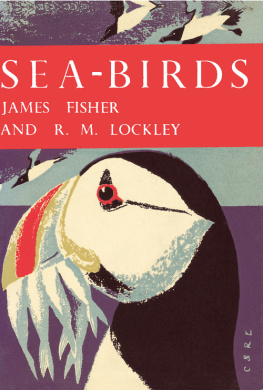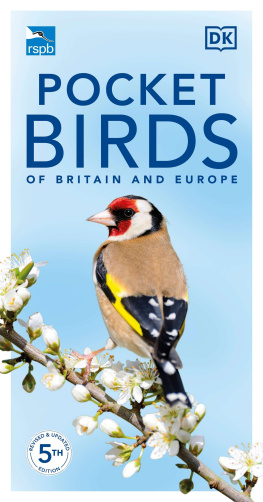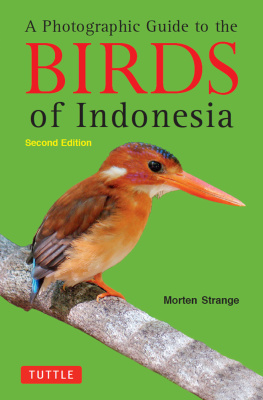
JAMES FISHER M.A.
JOHN GILMOUR M.A.
JULIAN HUXLEY M.A. D.SC. F.R.S.
L. DUDLEY STAMP C.B.E. D.LIT. D.SC.
PHOTOGRAPHIC EDITOR:
ERIC HOSKING F.R.P.S.
The aim of this series is to interest the general reader in the wild life of Britain by recapturing the inquiring spirit of the old naturalists. The Editors believe that the natural pride of the British public in the native fauna and flora, to which must be added concern for their conservation, is best fostered by maintaining a high standard of accuracy combined with clarity of exposition in presenting the results of modern scientific research. The plants and animals are described in relation to their homes and habitats and are portrayed in the full beauty of their natural colours, by the latest method of colour photography and reproduction.
To
JULIAN HUXLEY
in gratitude for his guidance
and encouragement,and in recollection of the
many happy days we have spent together,
watching sea-birds

IT IS NATURAL that in a series dealing with the wild life of the British Isles sea-birds would be a subject planned for early publication; and in fact this book was announced as forthcoming five years ago. That it has not been completed earlier is not due to any want of industry on the part of its authors. On the contrary, in their researches for this book they have found their subject so absorbing that they have made the interval an opportunity to continue to publish numerous scientific papers, and two monographs, on sea-birds. James Fisher is the author of The Fulmar (1952); and R. M. Lockley, author of Shearwaters (1942), has just published Puffins (1953). There could, in fact, hardly be any other pair of authors better qualified to describe the sea-birds of the North Atlantic than these with their experience of many years of field work and visits along the coast and islands, from Spitsbergen and Iceland in the cool north, to Madeira and the Salvages in the warm south, of that great demi-ocean. They have made their visits often together, and lived much on the small remote islands where sea-birds breed.
The North Atlantic, busiest ocean in the world, is revealed in the opening chapters not as a monotonous watery plain, but as an intricately varied, densely inhabited foraging ground for sea-birds. This avian community, though remarkably homogeneous in different sections of the broad expanse of the North Atlantic, is fascinating in the variety of the species that compose it, and in the complexity of their movements and migrations. The annual migrations of some species extend the total range of the community from the arctic to the antarctic. These long transatlantic migrations, verified by ringing, take species from east to west between Europe and North America, and from north to south between Greenland and South Africa, Britain and South America.
The authors tell us of the primitive progenitors of the sea-birds, dating from over sixty million years ago, and the evolutionary adventures of their descendants, including the notorious extinction of the strange flightless great auk, the sad decline of many other fine species, also the rediscovery of the cahow after it had been presumed extinct. They have paid special attention to geographical distribution, and have provided a unique collection of maps, giving us, for the first time, the distribution of most species of North Atlantic sea-birds.
Chief among the authors interests has been the study of sea-bird numbers. They were largely responsible for organising the surveys of that splendid and typical North Atlantic animal, the gannet, which provided biology with the first reasonably accurate figure for the world population of any single and fairly numerous bird species. They have, from their own notes and those of many amateur and professional bird-watchers, produced interesting statistics of the total population of the fulmar, the Manx shearwater, the puffin and many others. Incidentally, such careful counts, site by site, reveal the continuous change that is going on in sea-bird populations, often directly or indirectly due to mans influence.
The chapters on life-history are preceded by a general account of social and sexual behaviour, which throws light upon the significance of the prolonged and, to the observer, entertaining, mutual ceremonies of these strictly monogamous birds, their pair-formation, their fidelity to their mates, their nest-sites and their parental duties; at the same time problems of instinct and learning ability are discussed. The life-histories include much original field-work by the authors, who have been responsible for several discoveries concerning the incubation and fledging of a number of sea-birds.
We read of the birds ecology, their sharing of the wild frontiers of the land where they nest, their niches in the economy of the ocean. We learn of the contrasts between cliff-dwelling and hole-nesting species, of how the guillemot and razorbill chicks, exposed to many dangers on the open rocks, hasten their feather-growth and depart to the sea in two weeks, while the young puffins, safe in the darkness of their burrows, delay their departue for seven weeks, and are finally deserted by their parents; we learn of the strange lives of the shearwaters and small petrels which wander after the breeding season between the North and South Atlantic Oceans, living in perpetual summerthe Tristan shearwater wintering in our northern summer, and the Manx shearwater enjoying its winter in the southern summer off the coasts of South America.
But we have said enough to indicate the richness of knowledge brought together in this volume, which we confidently recommend as indispensable to everyone interested in the birds of the sea.
THE EDITORS

THE HEROES of our story are rather over a hundred species of birds whose life is a sea-life, whose habits enable them to earn at least part of their living in, or on, salt water, and which have been seen in the Atlantic Ocean north of the Equator.
The North Atlantic is the scene of our book, the great ocean that is now the most travelled by man. Its two sides are provided with an almost equal variety of sea-birds: sixty-eight species, or rather over half are common to both. Of all Atlantic countries Britain, considering its size, has the greatest number of sea-bird species; with no less than eighty, it can boast on its list all but six of those that have been seen on the Atlantic coast of Europe. The British Isles therefore make a good headquarters for a survey of the sea-birds of the North Atlantic. In Britain, and from Britain, the writers of this book have explored the eastern Atlantic sea-bird stations, and enjoyed many fine islands and memorable experiences. One or the other of us has sought the sea-birds south to the frigate-petrel burrows of the Salvages, near the Canary Islands; north to the ivory-gull colonies on the nunataks that rise from the ice-cap of Spitsbergen; or from 30N. nearly to 80N., a distance of more than three thousand miles; west we have ranged to Iceland, the Faeroes, Rockall, St. Kilda and the Blaskets of the Kerry coast; east we have travelled to Heligoland, and as far as Laes in the Kattegat and Gotland in the Baltic, with their off-lying islands of sea-birds. There is no coastal county in England, Wales and Scotland that has not been visited by us both, and not one in Ireland that has not been visited by one of us.
Next page











